Crashes at the Tour de France
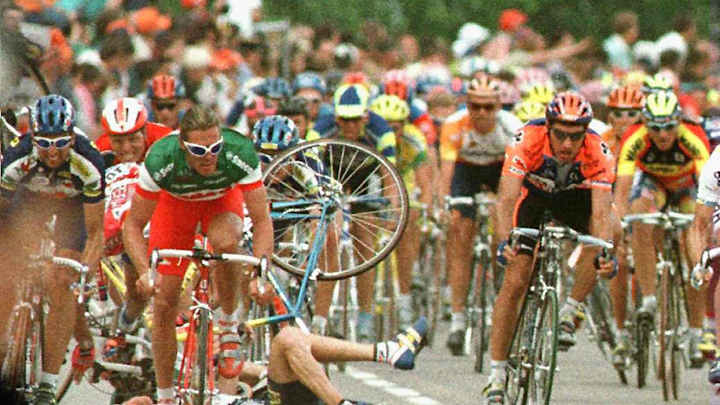
Crashes at the Tour de France
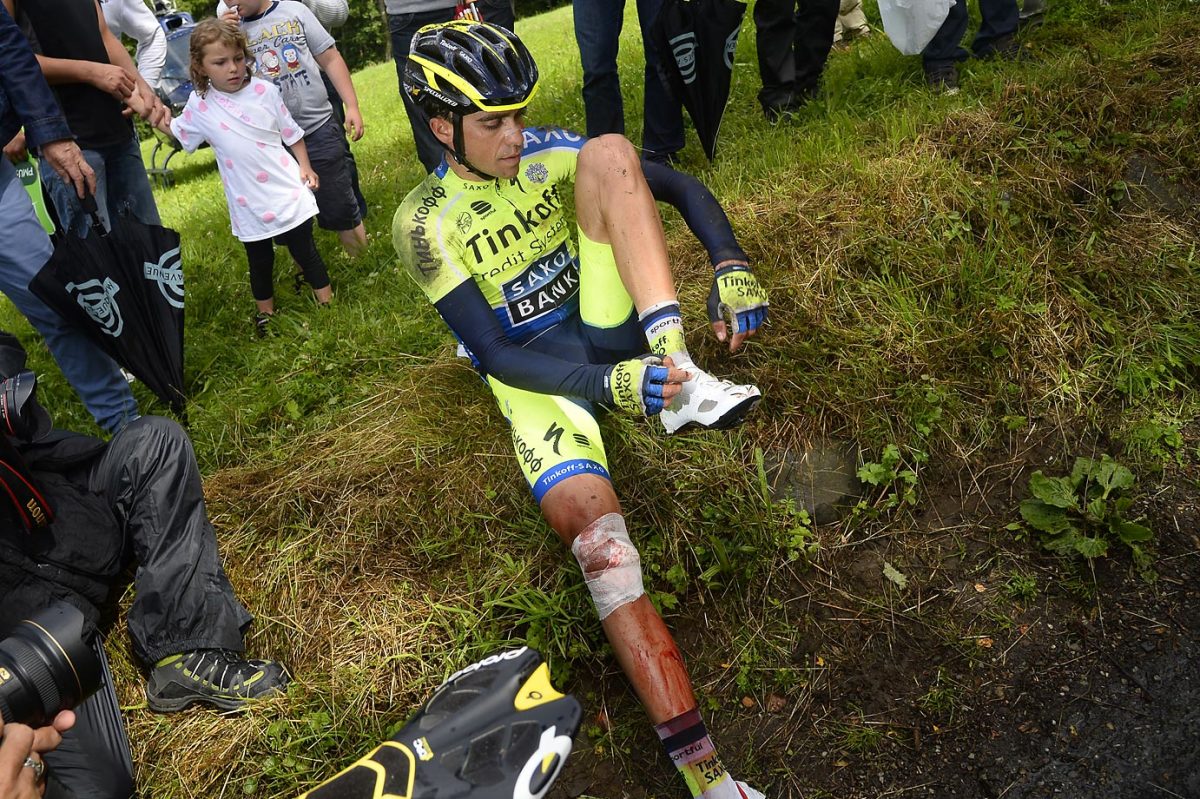
It’s a measure of Contador’s toughness that, after crashing heavily on Monday, then replacing his destroyed left shoe, he remounted and rode another 20 kilometers with a fractured right tibia, before finally, tearfully pulling the plug.
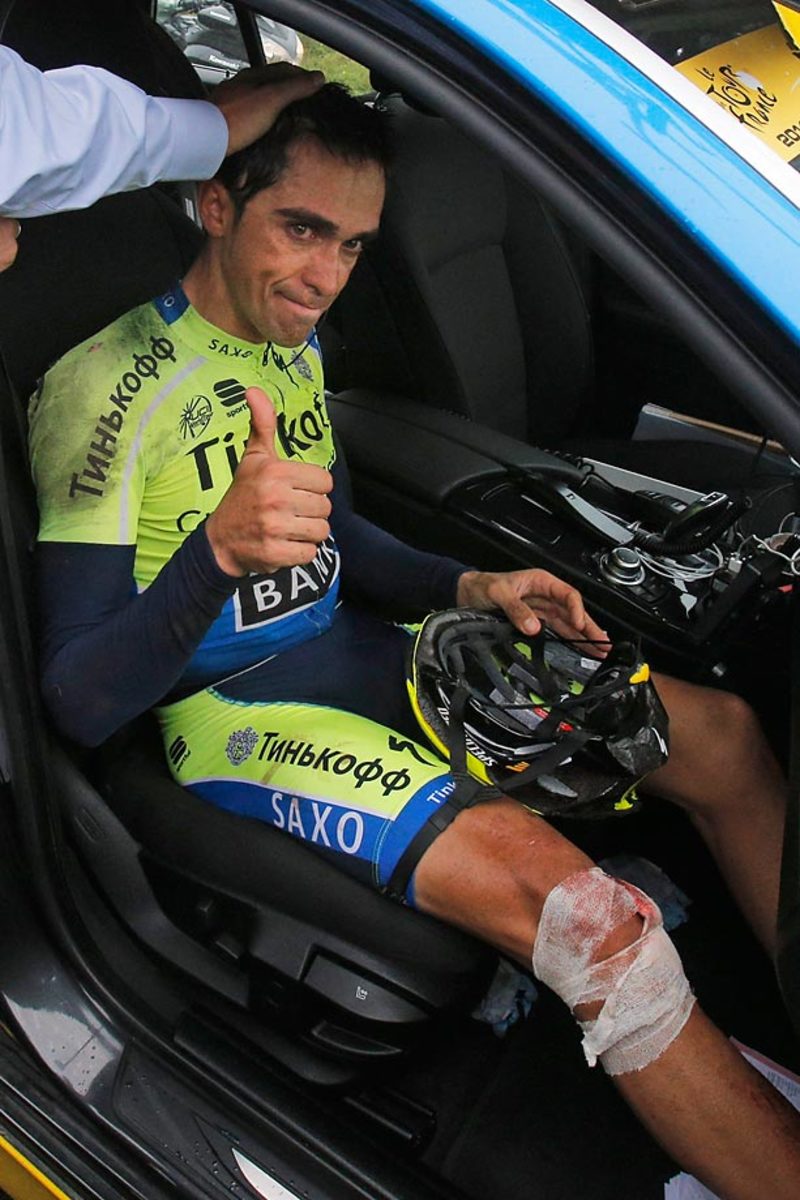
Shortly after Contador was forced to abandon, his erstwhile rival Chris Froome – who’d pulled out five days earlier -- graciously tweeted: “Big loss for the TDF today. Recover well @albertocontador & I hope to see you at the Vuelta.”
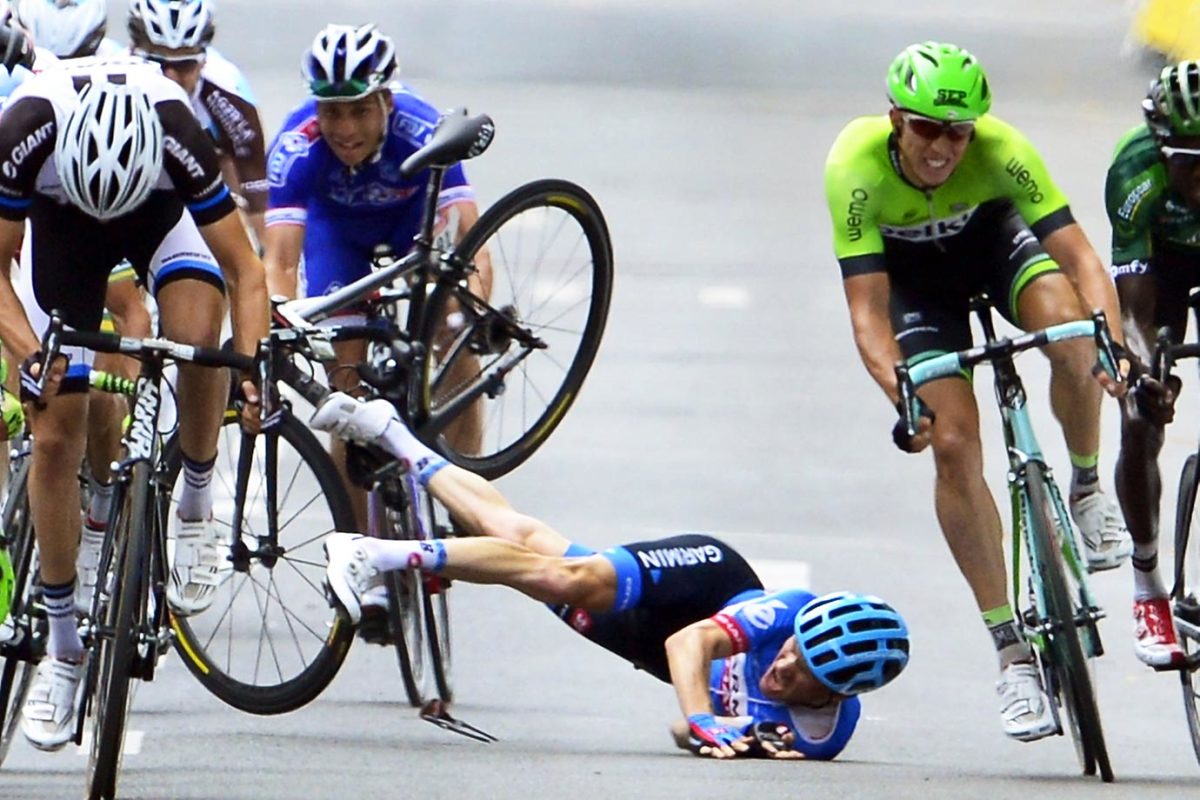
Realizing, perhaps, that he was out of his element amidst a bunch of pure sprinters at the end of Stage 7 at the 2014 Tour, Garmin-Sharp rider Andrew Talansky looked for the exit, but in so doing crossed wheels with Australian Simon Gerrans. Executing a nifty tuck and roll, Talansky bounced up quickly. But he fell hard again the next day, and lost 10 minutes to the leaders the day after that. The crashes had caught up to him.

Due to the high speeds, the density of riders and the borderline-recklessness that’s a prerequisite for all sprinters, bunch sprints are recipes for crashes, such as this one at Stage 4 of the ’96 Tour. While the great Mario Cipollini (no helmet) stayed upright – less lucky were Mauro Bettin, Laurent Brochard and Jan Svorada – he was beaten to the line by France’s Cyril Saugrain.
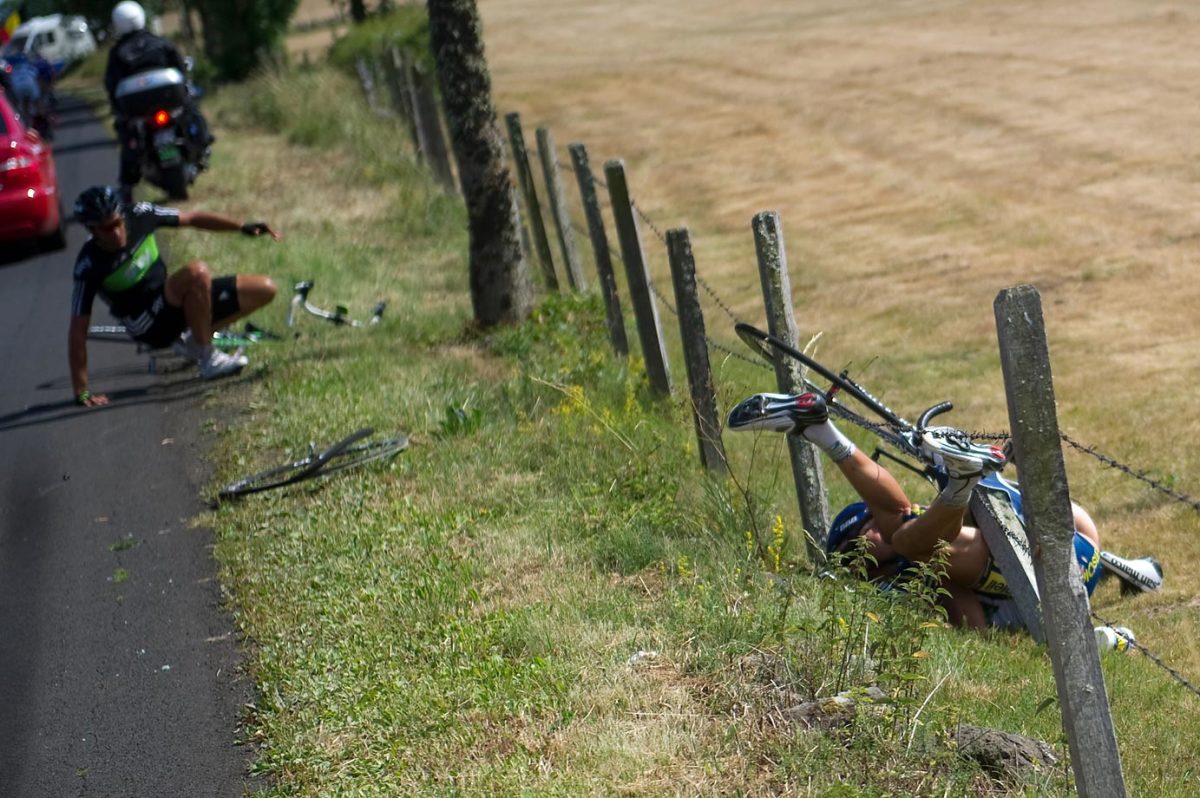
Juan Antonio Flecha (left) and Johnny Hoogerland (entangled in fence) were run off the road by a shockingly reckless driver in stage 9 of the 2011 Tour. Hoogerland went flipping into a barbed wire, suffering deep cuts that would take 33 stitches to close. Incredibly, he and Flecha both finished the stage, and were jointly awarded the Tour’s “Combativity Award” for the day. The driver of the car, belonging to France Television 2/3, was expelled from the race.
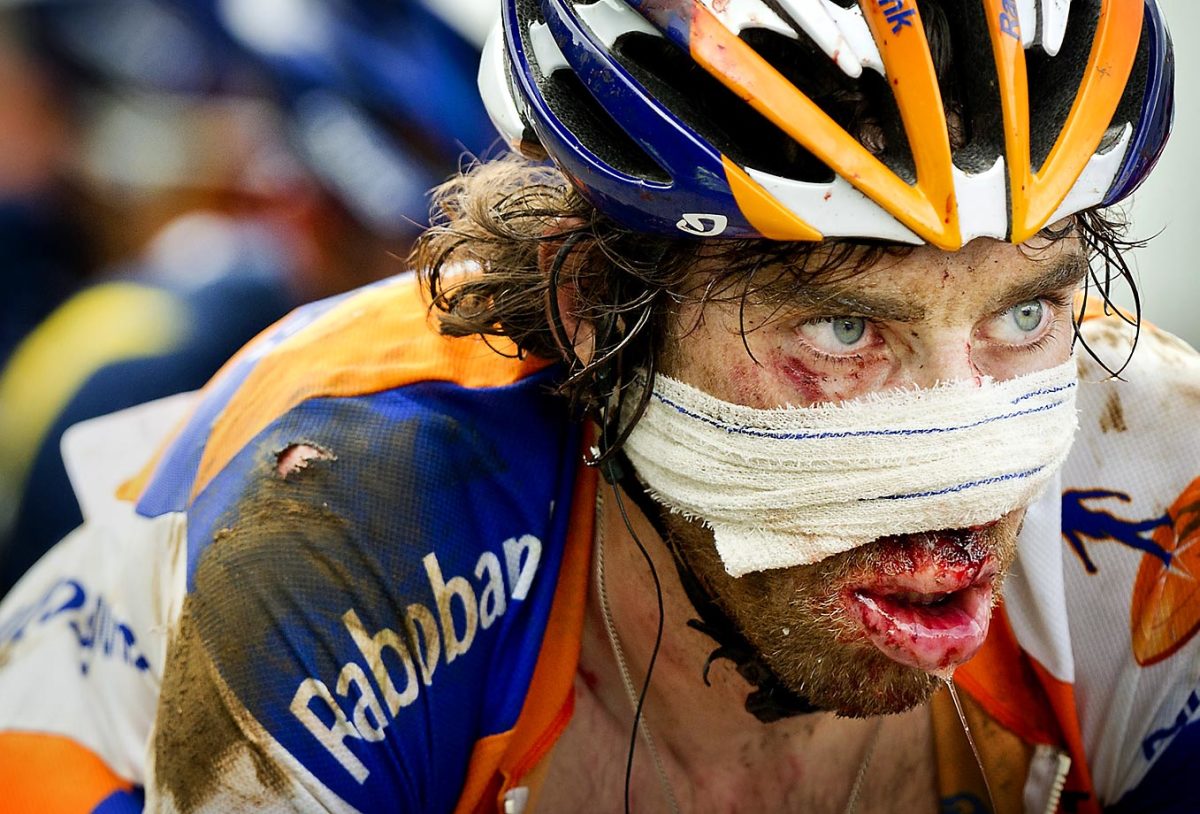
Five days after Hoogerland was sent flying, his Rabobank teammate Laurens ten Dam somersaulted off his bike on a high-speed descent of the Col d'Agnes, landing face-first in a ditch. He took the start the next day, deep gashes on his nose requiring eight stitches, “Still 25 fewer than Johnny,” he noted.
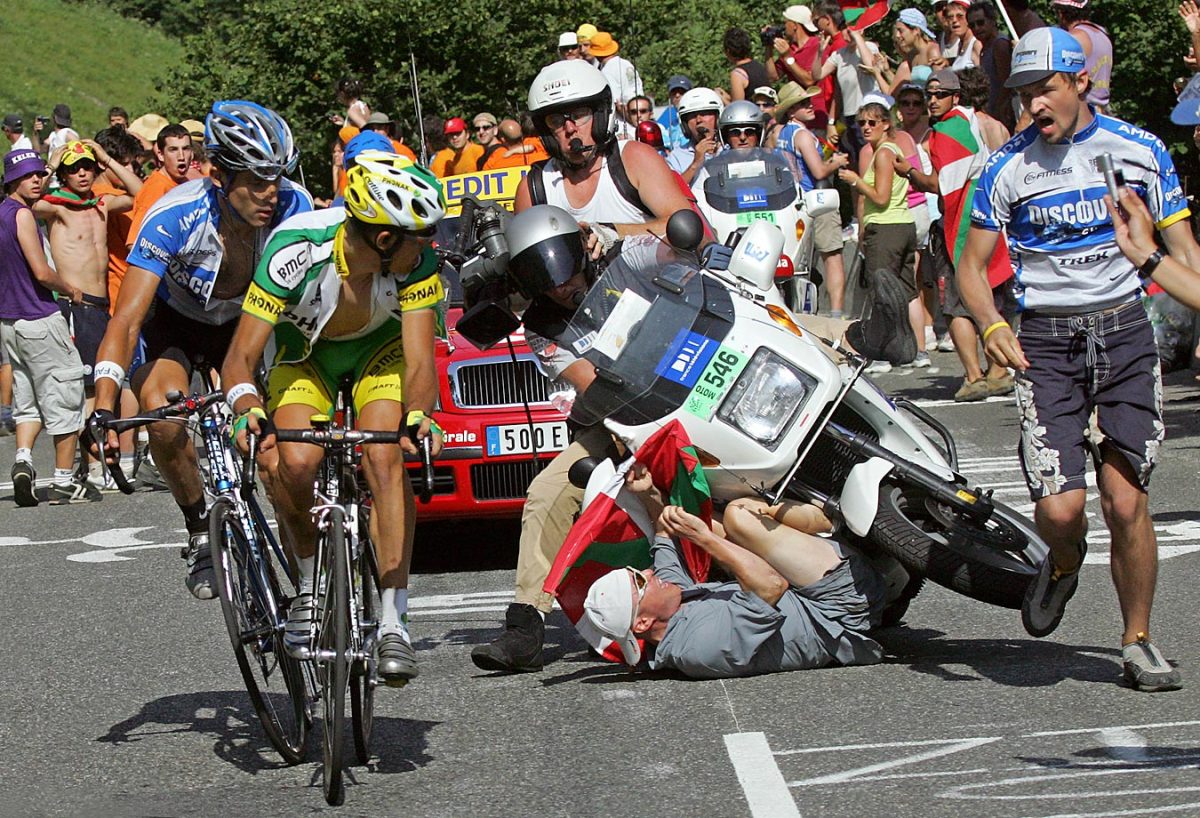
As George Hincapie dueled with Oscar Pereiro up the slopes of a Pyrenean peak called the Pla d’Adet – Lance’s lieutenant won this 15th stage of the ’05 Tour, but was stripped of the victory for doping – a fan got too close, and was run over by a motorcycle. The marvel is that it doesn’t happen more often.
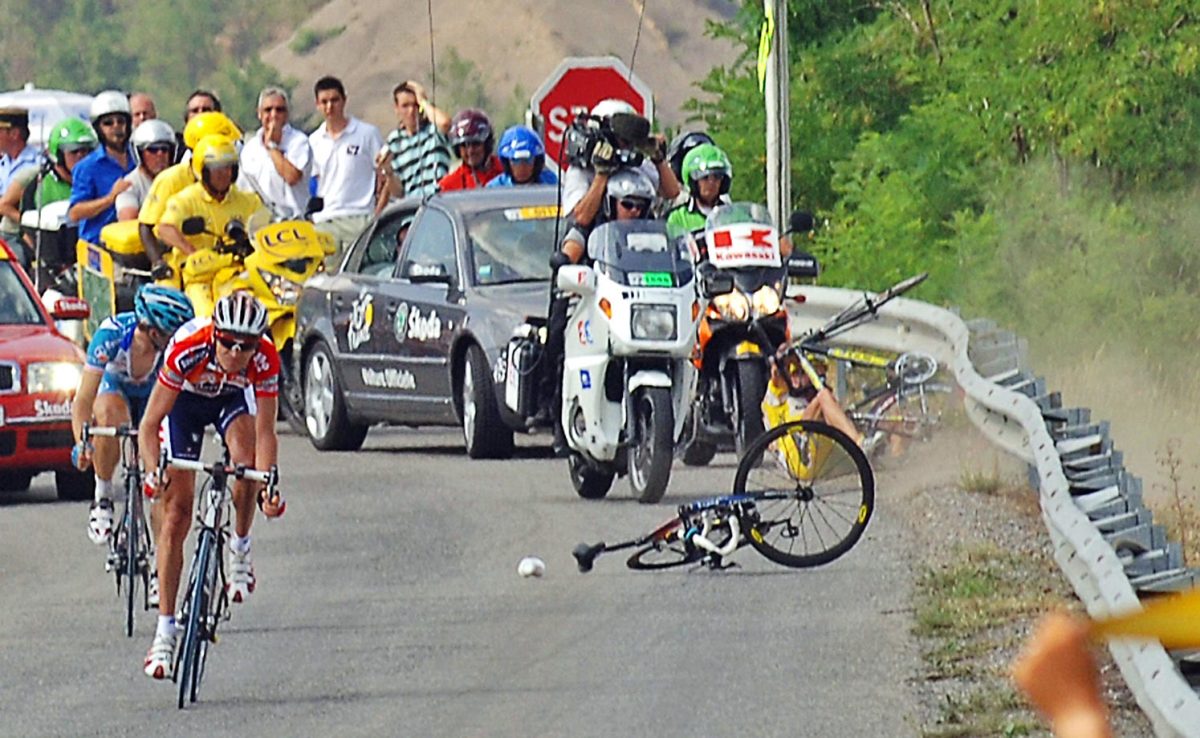
Verbrugghe again, this mishap coming four years later, during Stage 14 of the ’06 Tour. The rider sitting on the pavement is the Spaniard David Canada. Verbrugghe, having flown over the guardrail and into a ditch, is not pictured. Both riders abandoned the Tour that day.
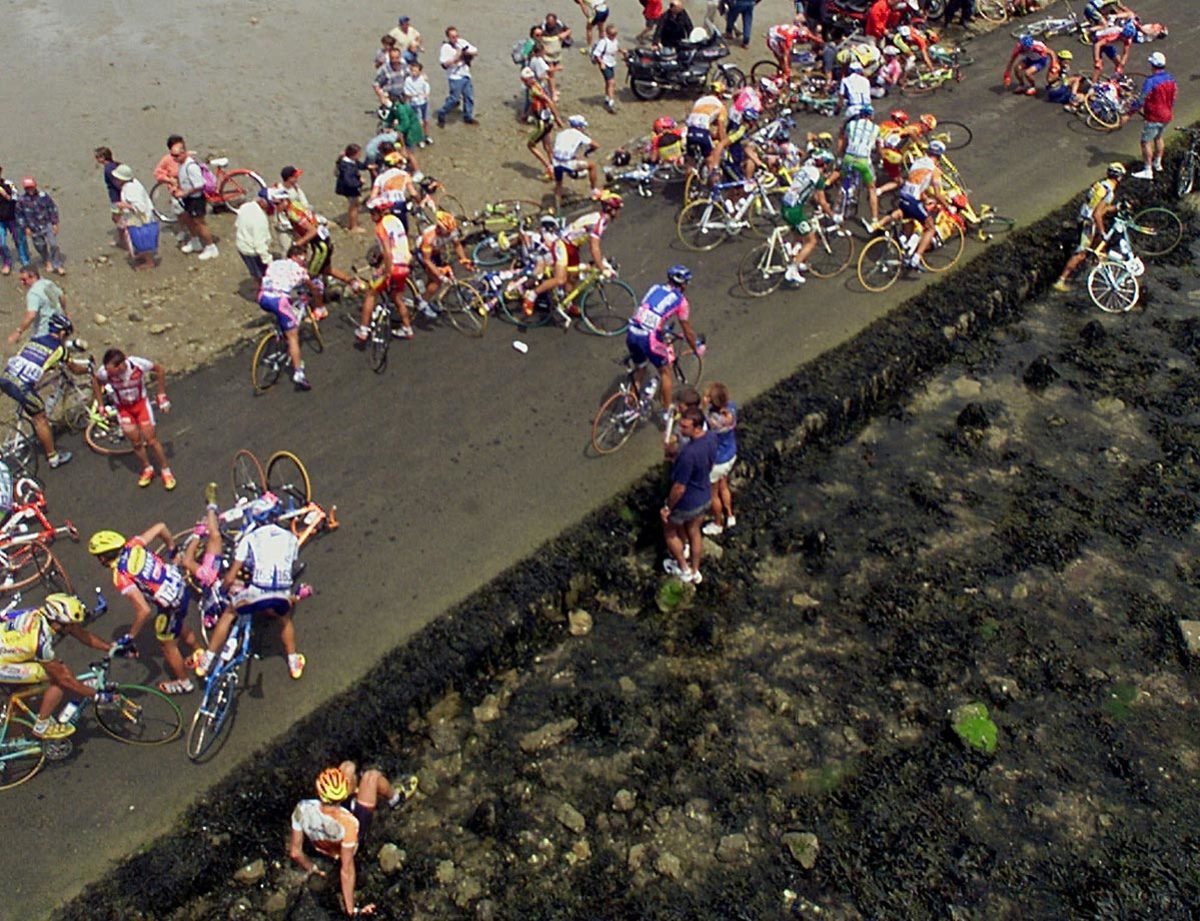
The race is cruel enough. Yet sometimes Tour officials can’t help themselves, adding devilish wrinkles, such as the day in 1999 when they sent the peloton across the slippery Passage du Gois, which is underwater during high tide and dangerously slick when exposed. This mass pileup on the Passage trapped a number of name riders behind it. Not among them, Lance Armstrong, who went on to win his first Tour that year.
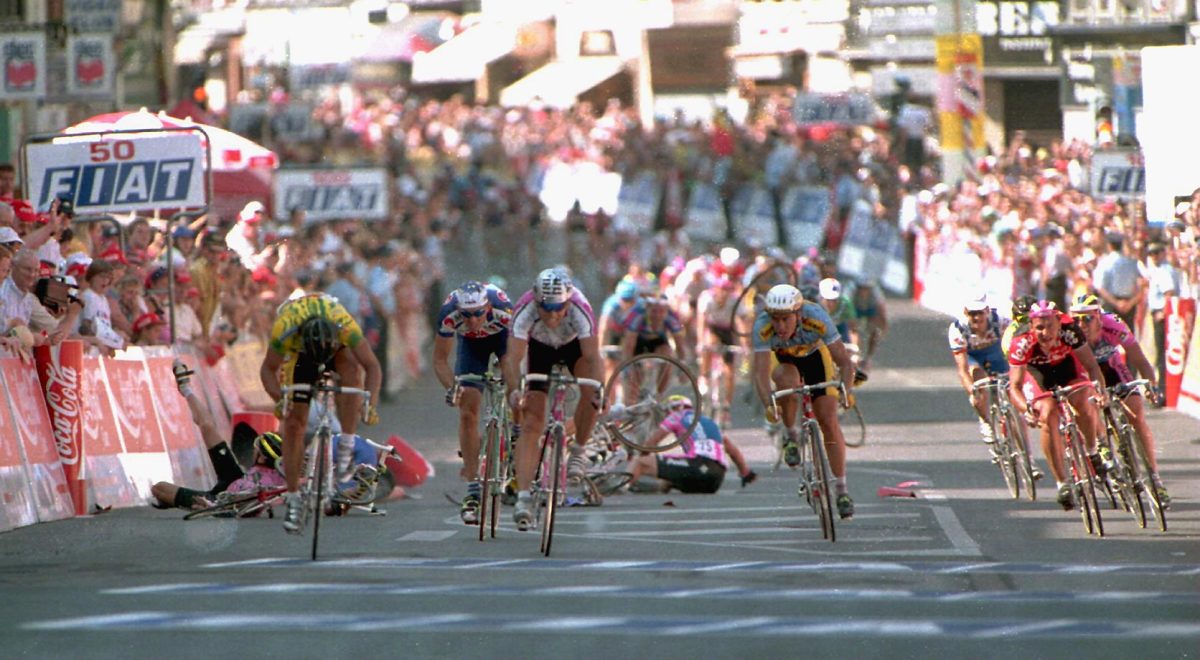
To the list of causes for crashes add this one: nincompoop policemen. A distracted gendarme standing in the road impeded the path of Wilfried Nellisen, who bowled over this real-life Inspector Clouseau and went down hard in the process. Nellisen took out Frenchman Laurent Jalabert: both riders were forced to retire from that Tour after just a single road stage.
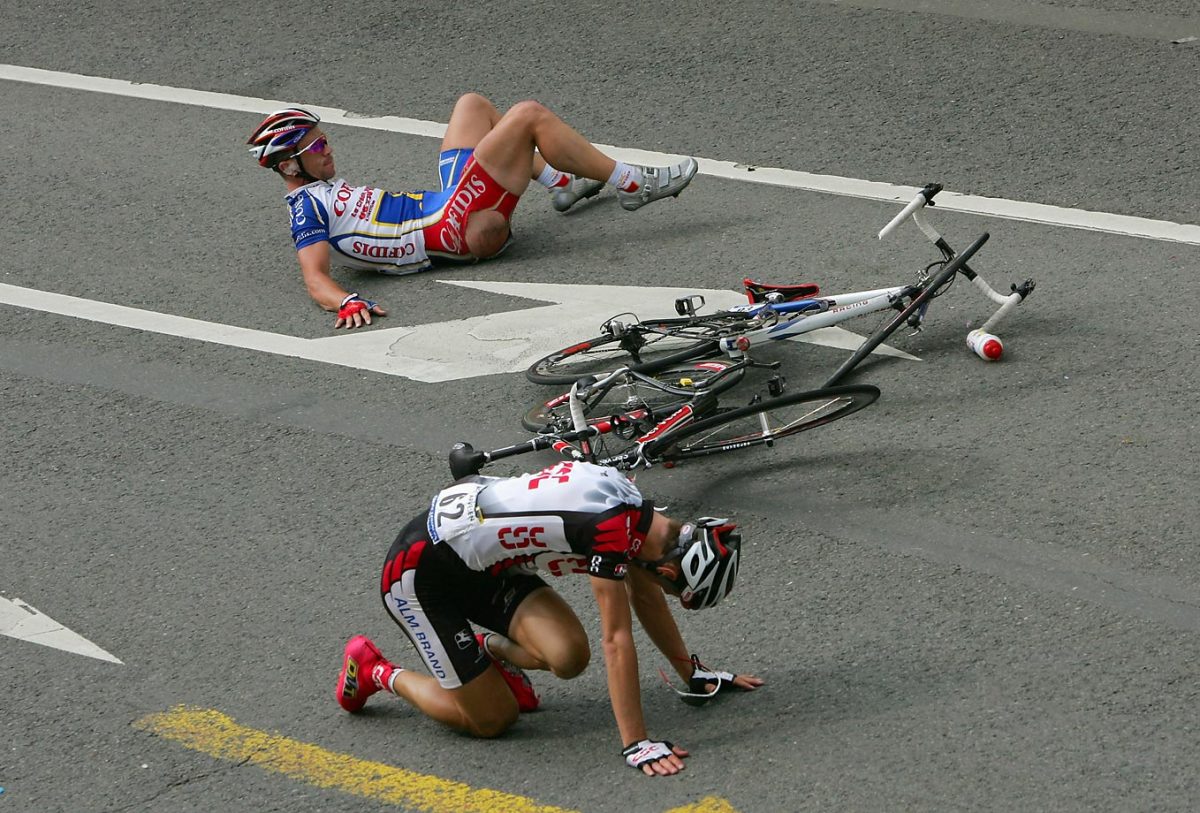
More bloodletting in the final meters. While Robbie (the Pocket Rocket) McEwen won the sprint ahead of them, Kurt-Asle Arvesen (bottom) and Jimmy Casper of France hit the deck hard in Stage 2 of the ’04 tour. Both riders remounted and finished that Tour – Casper dead last, in 147th place. But he finished.
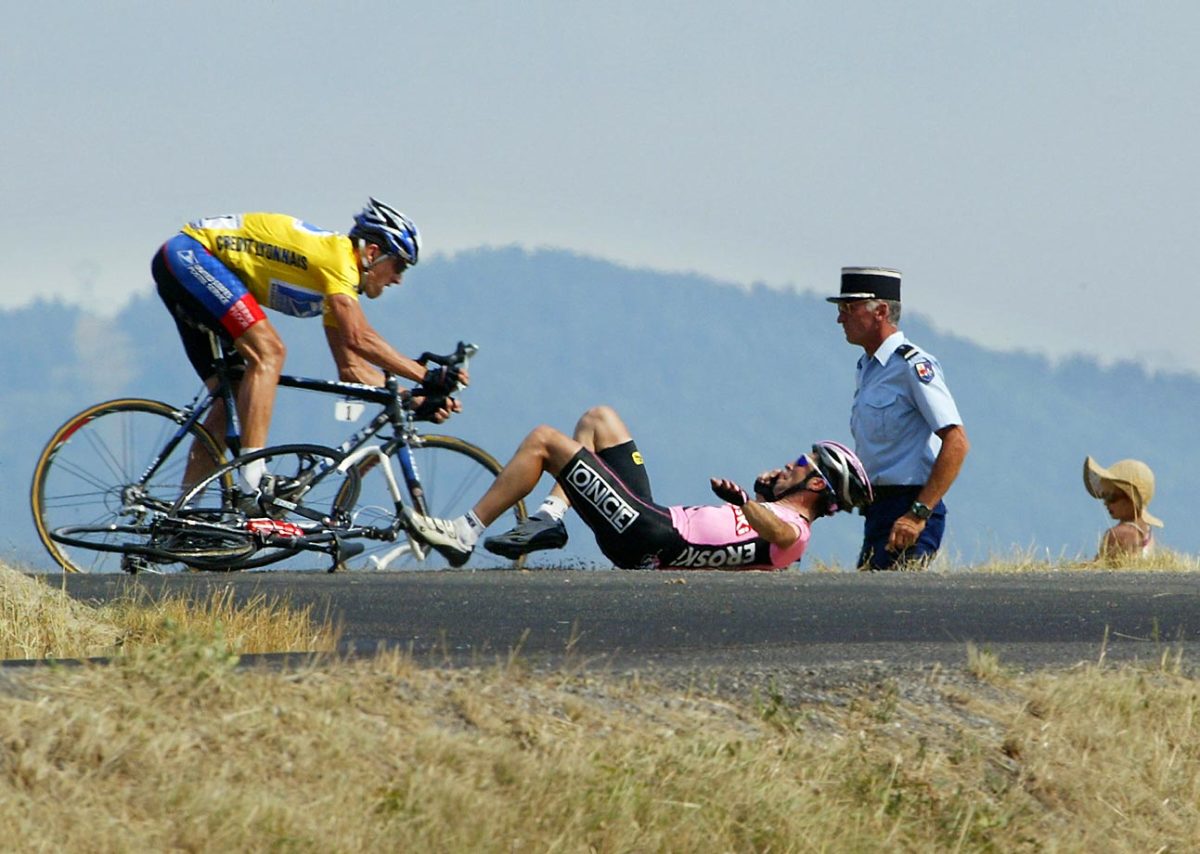
Joseba Beloki was climbing superbly during the '03 Tour, and looked like one of only a few riders capable of challenging Lance Armstrong. Descending too aggressively on asphalt softened by sweltering heat, the Spaniard lost control of his bike – forcing Armstrong, famously, to go off-roading. Slamming into the pavement, the Spaniard fractured his right thigh, elbow and wrist. Three times a top-three finisher, Beloki was never the same rider, thereafter.
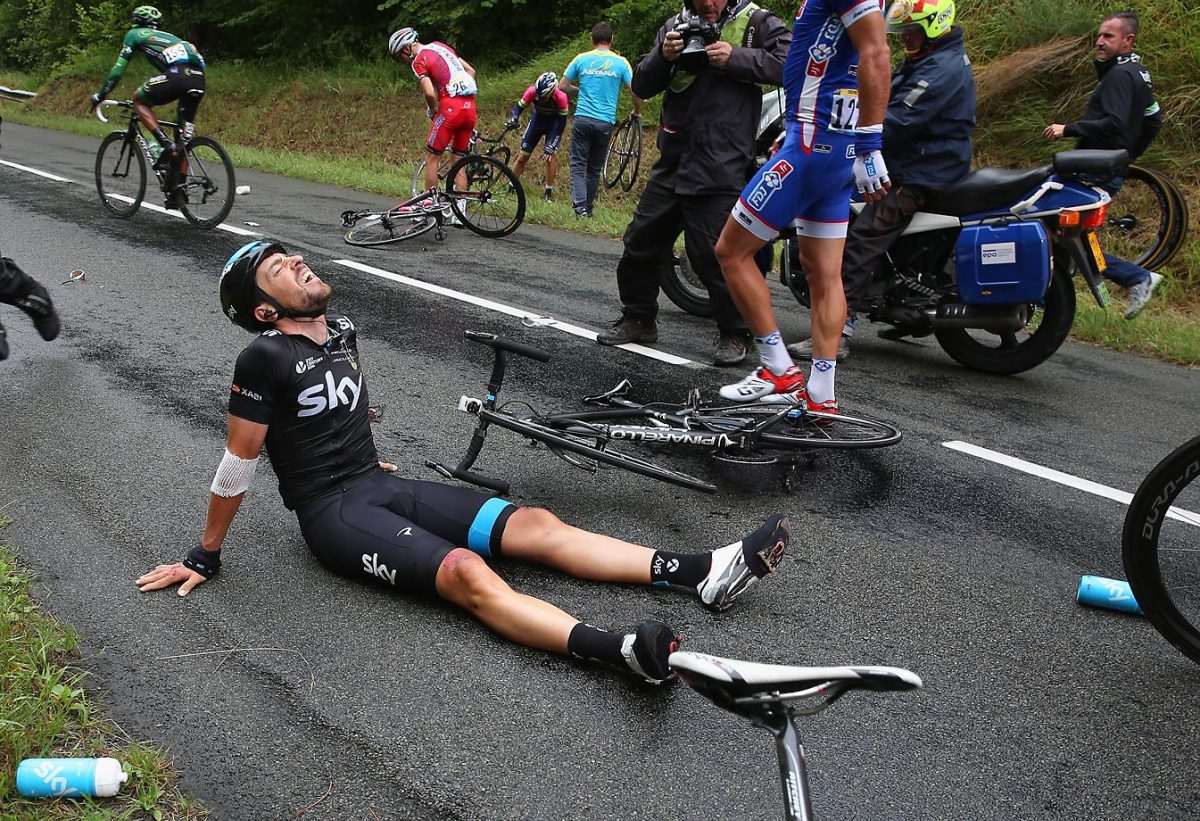
When it rains, it pours. A day after Froome pulled out, ceding Team Sky leadership to Richie Porte – who’d weathered a series of crashes himself – the man who Porte might have leaned on heavily in the high mountains, the reliable, 37-year-old Xabier Zandio, became entangled with some other riders and found himself sitting dazed on the pavement, then, shortly after, staring up at the roof of an ambulance. Porte will miss him in the second half of the race.
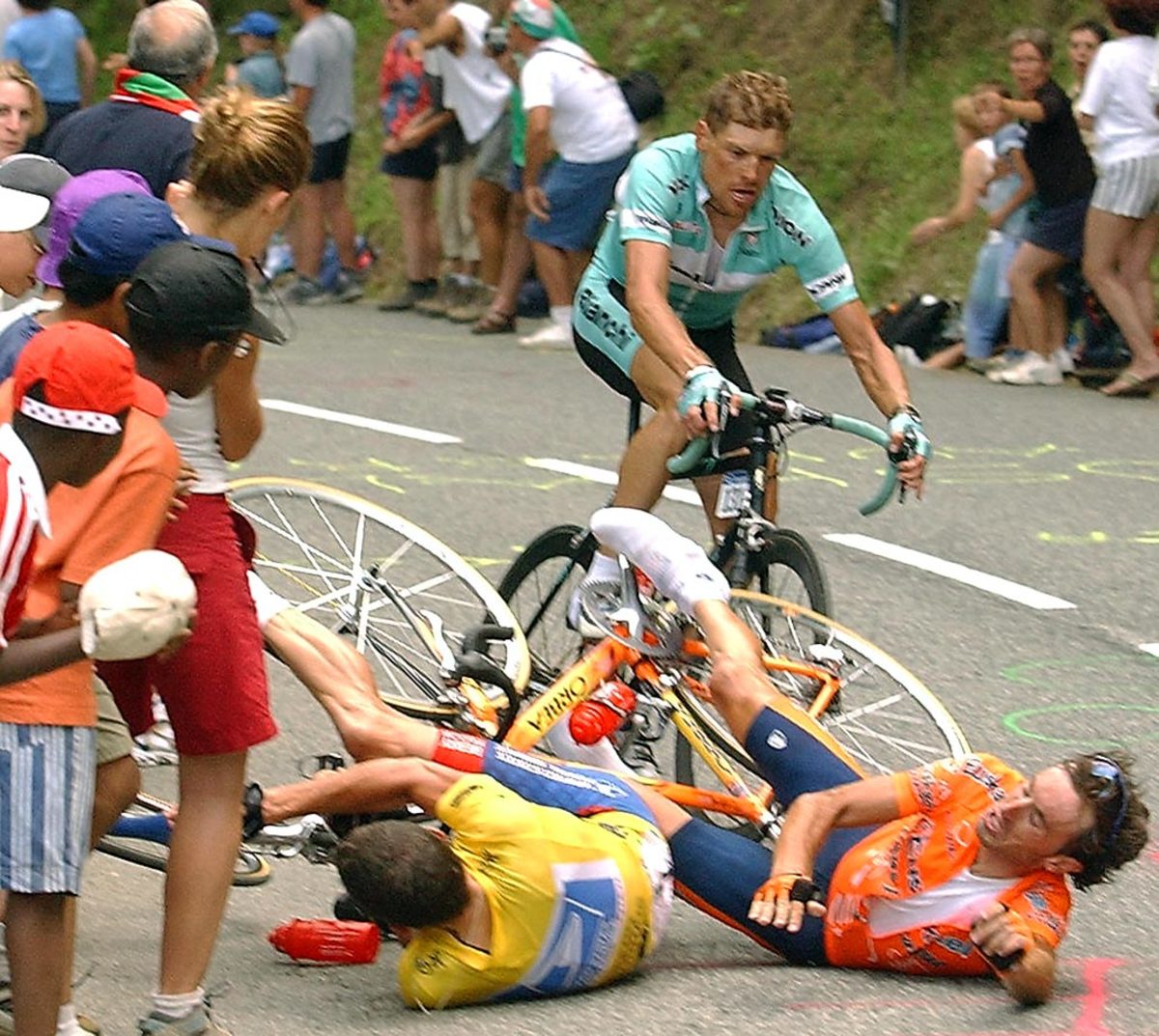
Trying to extend an uncomfortably slender lead over Jan Ullrich, Armstrong was setting a lively pace up Luz-Ardiden late in the '03 Grand Boucle when his right brake caliper snagged a spectator’s musette, bringing down both the Texan and Spaniard Iban Mayo. After re-joining the small group of riders who’d slowed to wait for him – an inspiring display of sportsmanship, until one considers that most of them were doped to the gills – Armstrong attacked them, then won the stage by nearly a minute.
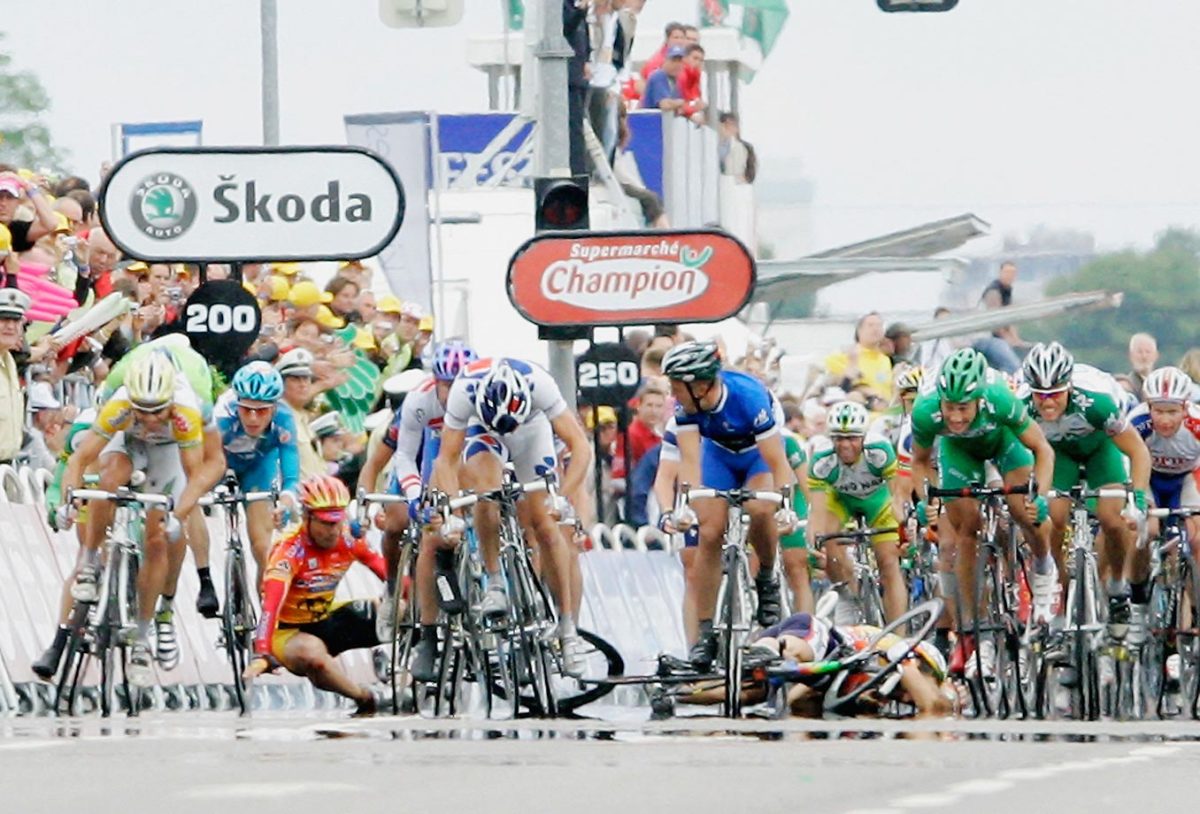
Another McEwen sprint victory, more carnage in his wake. Like Cipollini, McEwen won an even dozen stages of the Tour – including this one, the 7th stage of the ’05 Tour, in Karslruhe, Germany.
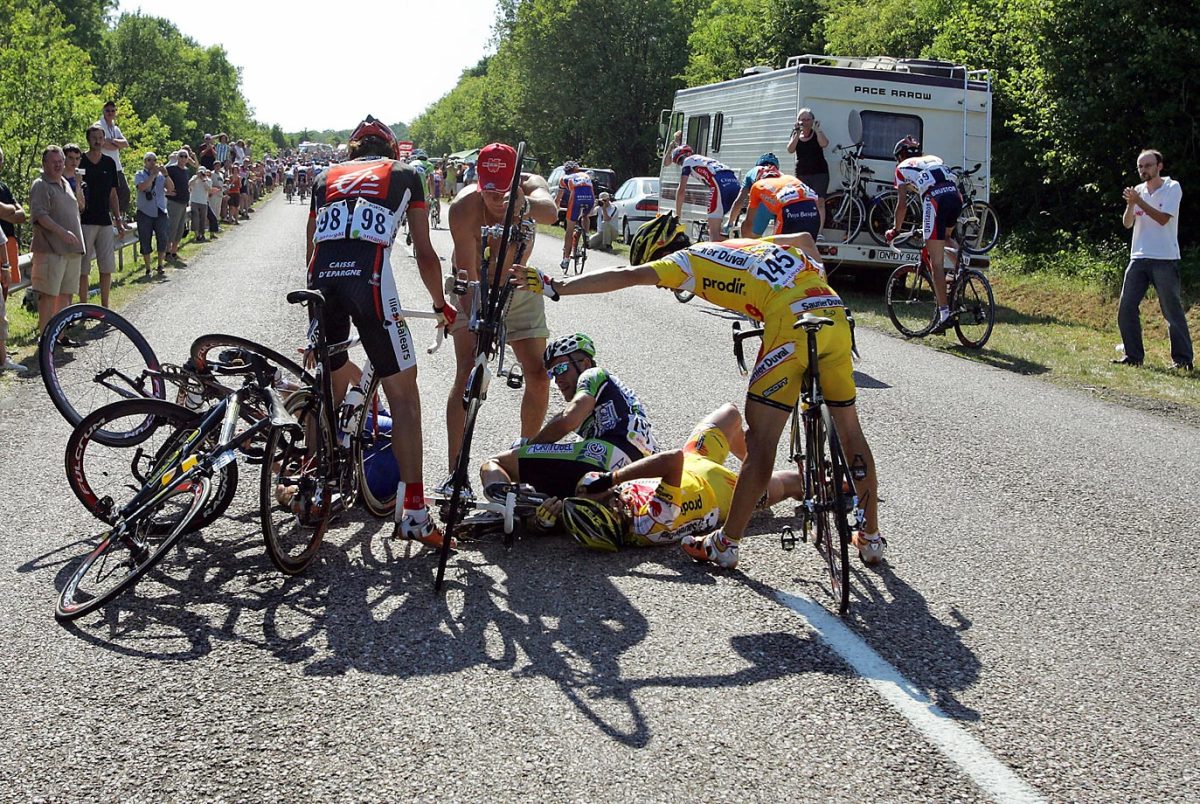
Hot days and long stages, such as this 228.5 km slog early in the 2006 Tour, lead to crashes. In addition to losing skin and blood – abrasions that adversely effect their sleep, their ability to recover – these crash victims all lost time. The need to get back on one’s bike, still bleeding, then go deep in the red simply to catch the main group, adds insult to injury.
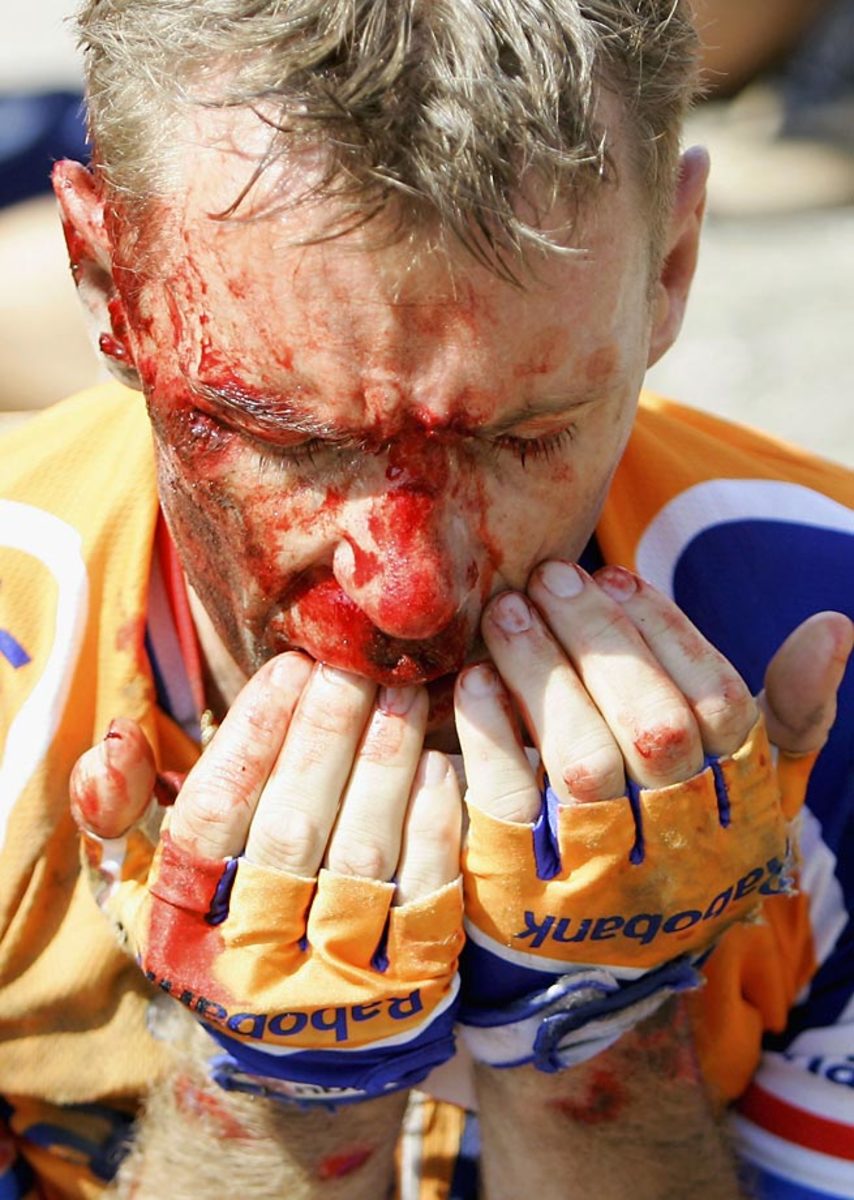
On Stage 3 of the ’06 Tour, Dutch rider Erik Dekker hit a pothole at a high speed, then hit the pavement face-first. He was taken by ambulance to a nearby hospital and put under general anesthesia so doctors could remove the pieces of gravel embedded in his face. He also chipped several teeth.
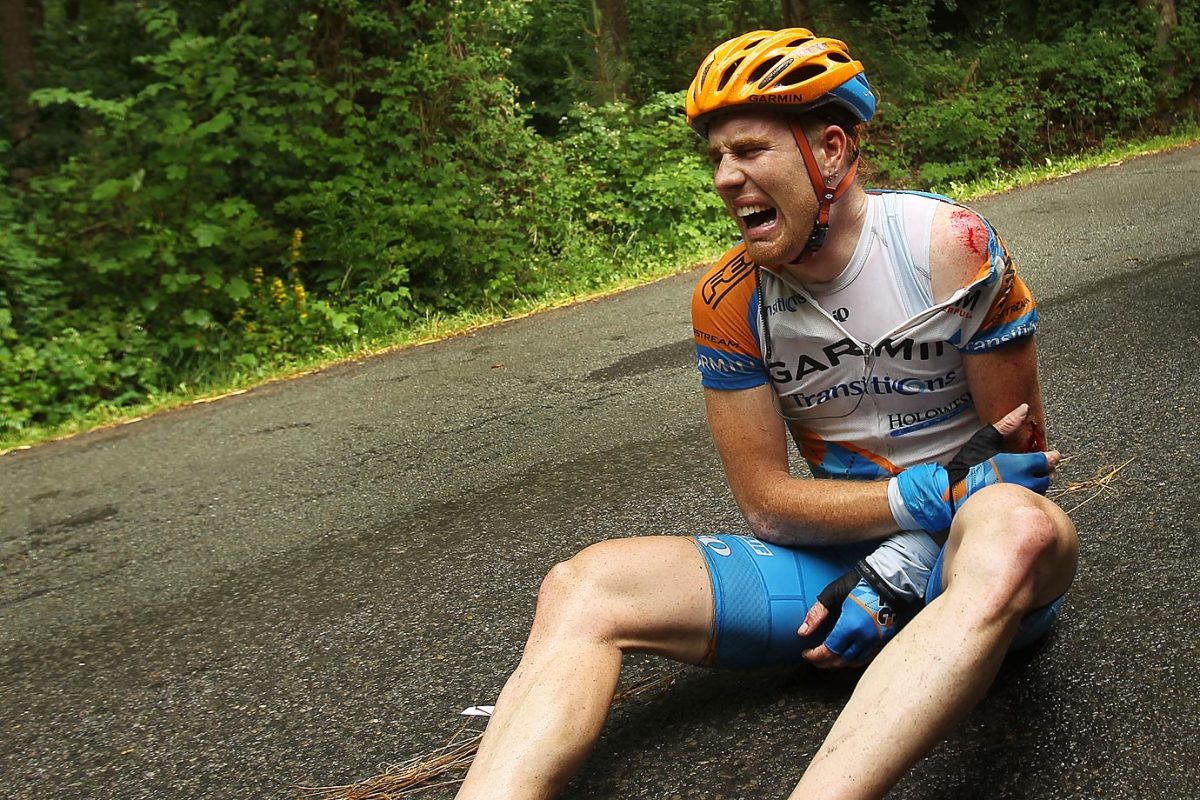
Sprinter Tyler Farrar was one of four Garmin-Transition riders to break bones in the 2010 Tour. In this Stage 2 crash in Spa, Belgium, the American sprained his left elbow, fractured his left wrist and suffered multiple other contusions and abrasions. He raced another week and a half before the pain forced him out of the Tour.
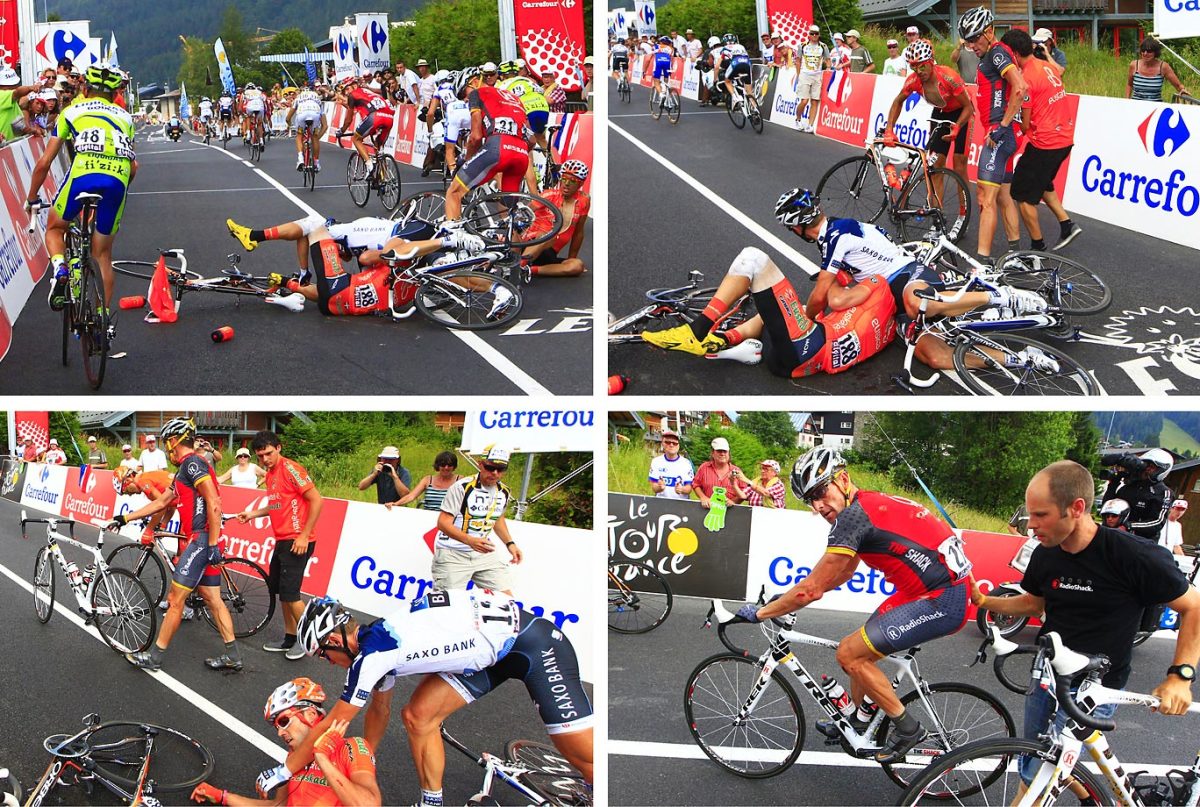
The sight was unusual, bordering on surreal. On the 2010 Tour’s first day in high mountains, seven-time winner, erstwhile patron Lance Armstrong was suddenly unable to stay upright. The Texan crashed three times, then was dropped by his rivals on the final climb, finishing 12 minutes behind them. Literally and figuratively bloodied, his Tour was effectively over.
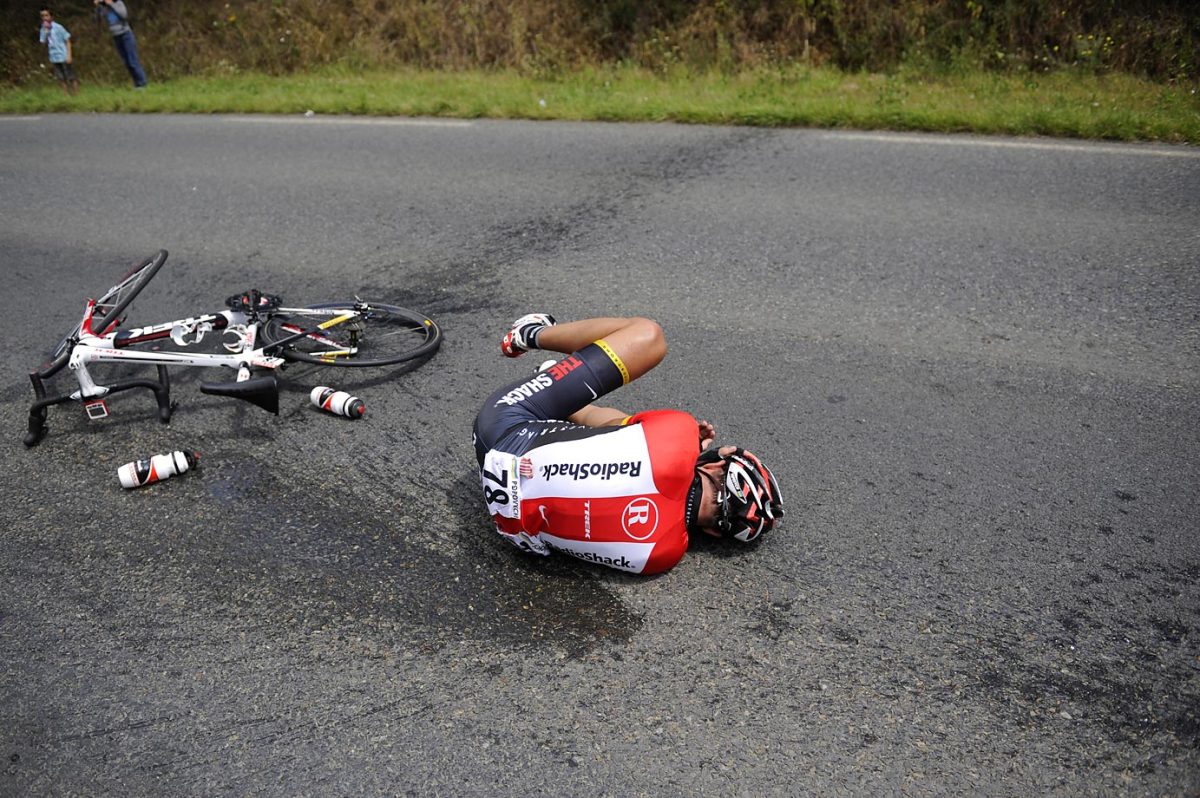
Team RadioShack’s Yaroslav Popovych crashed hard not once but twice during Stage 5 of the 2011 Tour, but remounted, and kept racing. Until the morning of Stage 10, when he abandoned the race due to … a fever.
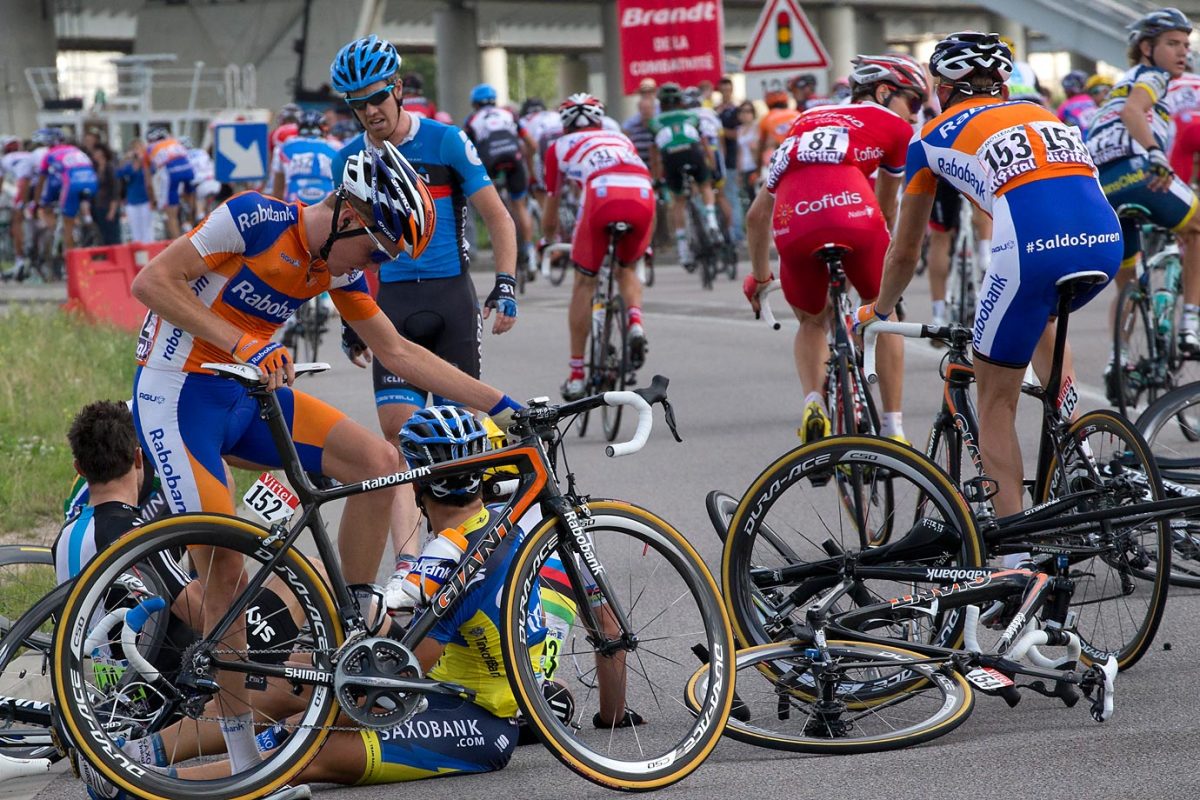
Riders are pictured after they crashed in the 214,5 km and fourth stage of the 2012 Tour de France cycling race starting in Abbeville and finishing in Rouen, northwestern France, on July 4, 2012.
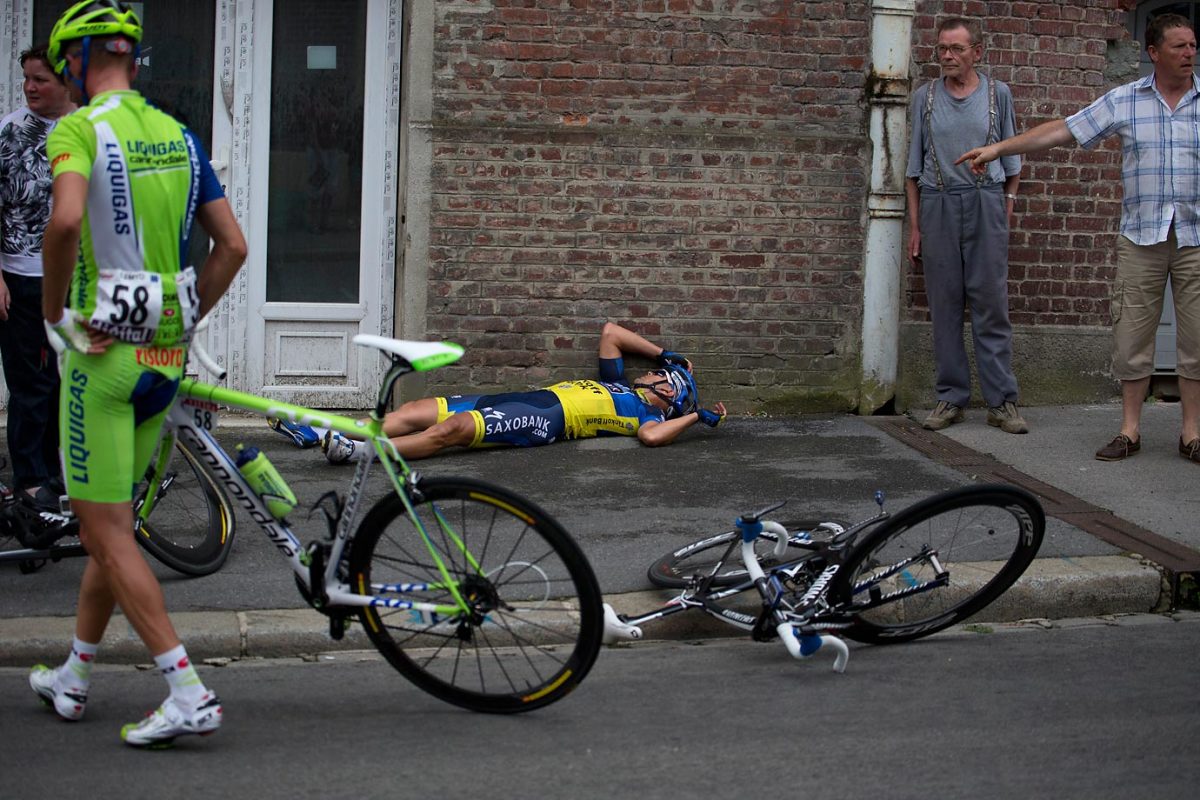
Australian Jonathan Cantwell (supine) takes inventory after crashing with Poland’s Sylvester Szmyd in Stage 5 of the 2012 Tour. After getting back on his bike and finishing the stage, Cantwell tweeted: “Very sore with half of my right ass missing and ankle taking a hit from the gutter.”
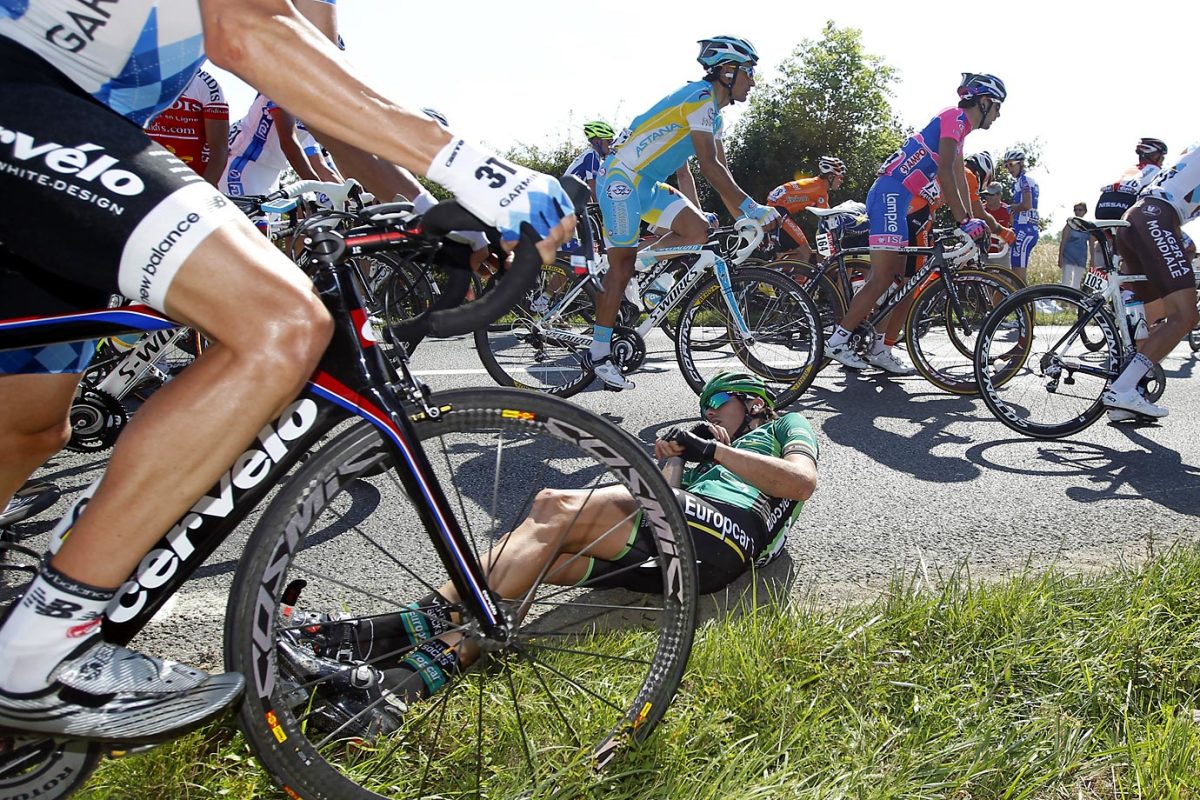
The Tour’s early, flat stages are always nervous. With so much at stake – a stage win in this race makes a career – more chances are taken, less quarter given. Here is French rider Vincent Jerome in the moments after he went down during the first stage of the 2011 Tour, hoping that no one runs him over.

Is that a smile, or a rictus? Here is Christian Vande Velde in the second stage of the 2010 tour, not along after a wipeout caused by a television motorcycle that had fallen on the road, and leaked oil. The cut over his left eye could not keep him from racing. The two broken ribs he is riding with did, eventually, prove to painful for him to go on.
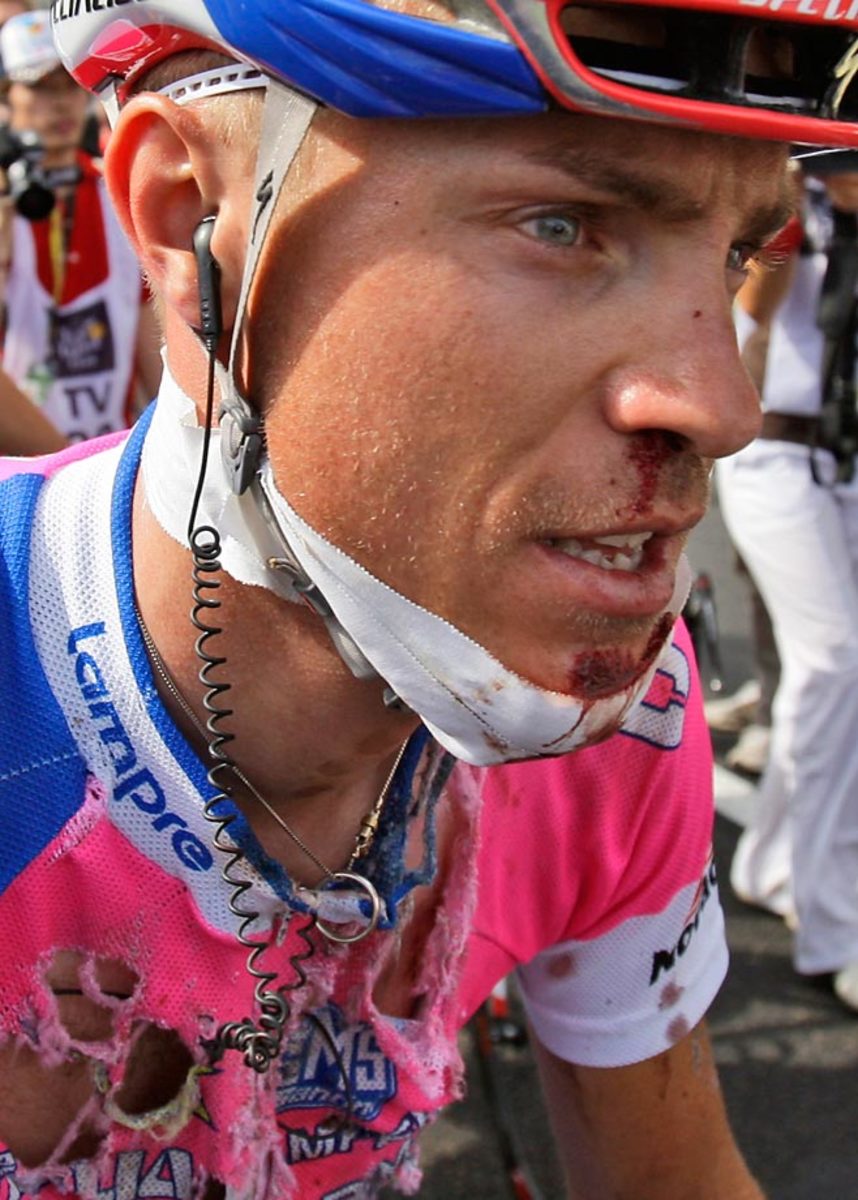
Damiano Cunego was a lock for the Top 10 in the 2008 Tour, until his front wheel got stuck in a gulley as the peloton crossed a bridge early in Stage 18. Losing control of his bike, the Italian hit a wall at speed, shredding his jersey and much of the skin on his face. After lying on the pavement for seven minutes, he rode 167 km to the finish line, but could not take the start the next day.
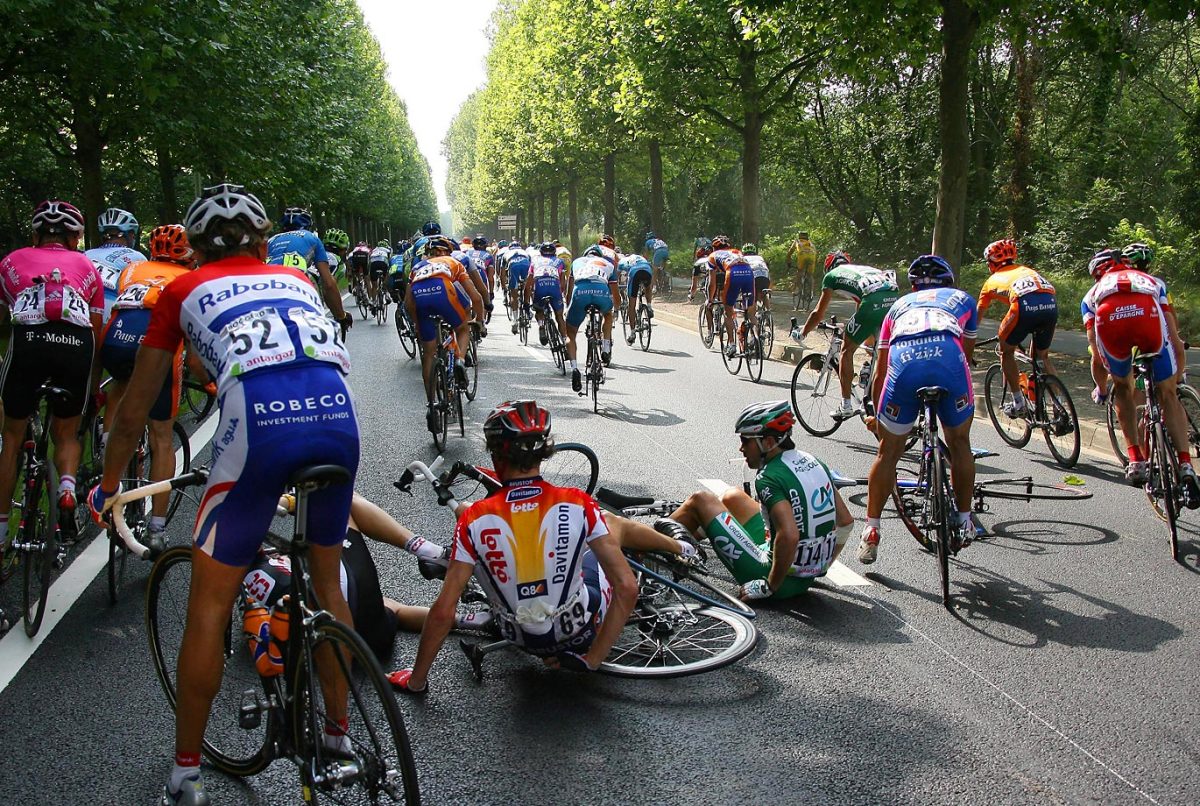
Crashes are a serious drain on morale. After hitting the deck during Stage 5 of the ’06 Tour, Kiwi sprinter Julian Dean wrote in his online diary: “Not quite sure what happened but dudes dropped it in front of me … I just kind of locked it up and ‘plopped’ over a couple of guys.” Tell us how you really feel, Jules: “I’m over this race. I know that tomorrow I will line up but after crashing AGAIN, in the last 3km today, I just don't feel like it.”
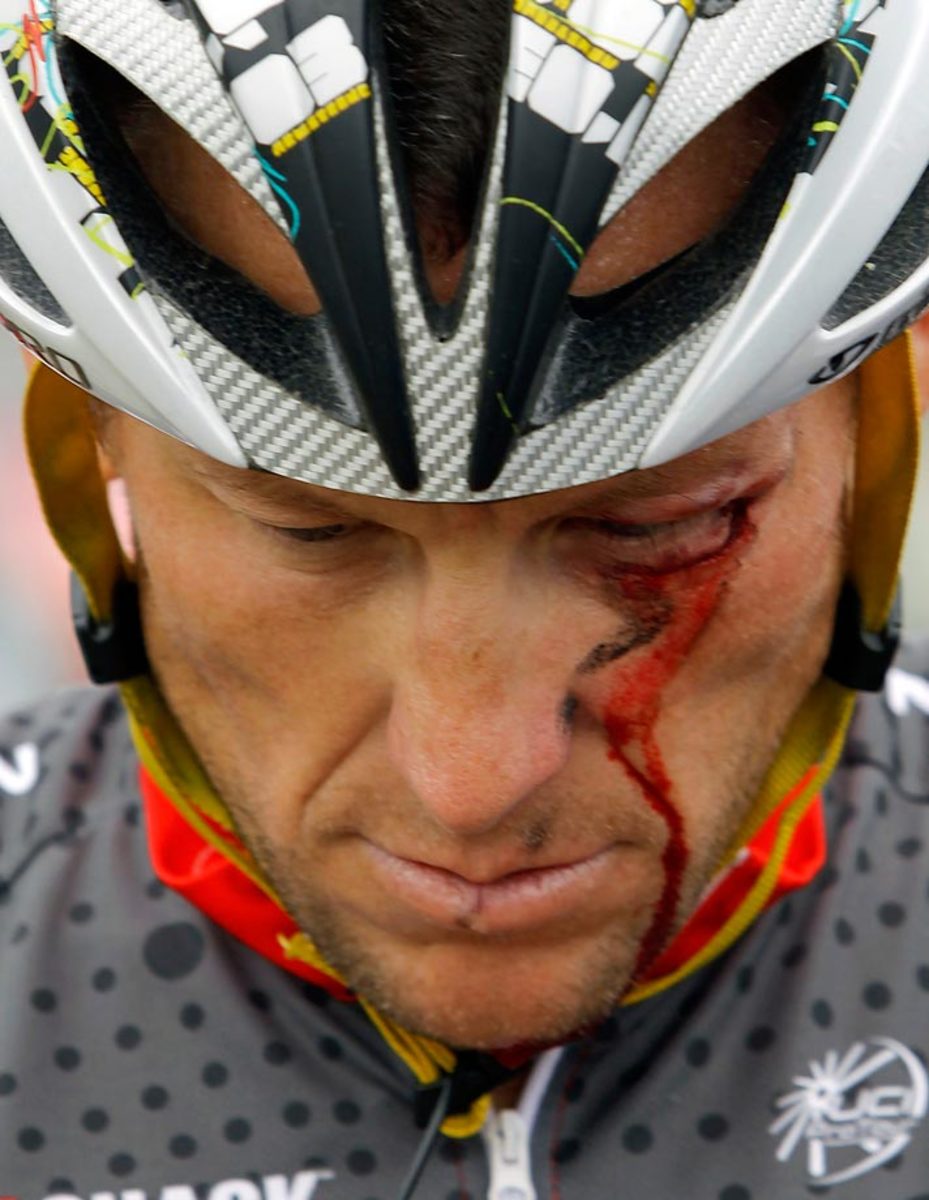
Vision of the future foretold: the same day the Wall Street Journal published damning allegations about systematic doping on Armstrong’s teams, May 20th, 2010, the Texan crashed out of the Tour of California. Armstrong would crash three more times during Stage 10 of that year’s Tour de France, losing the race on that day.
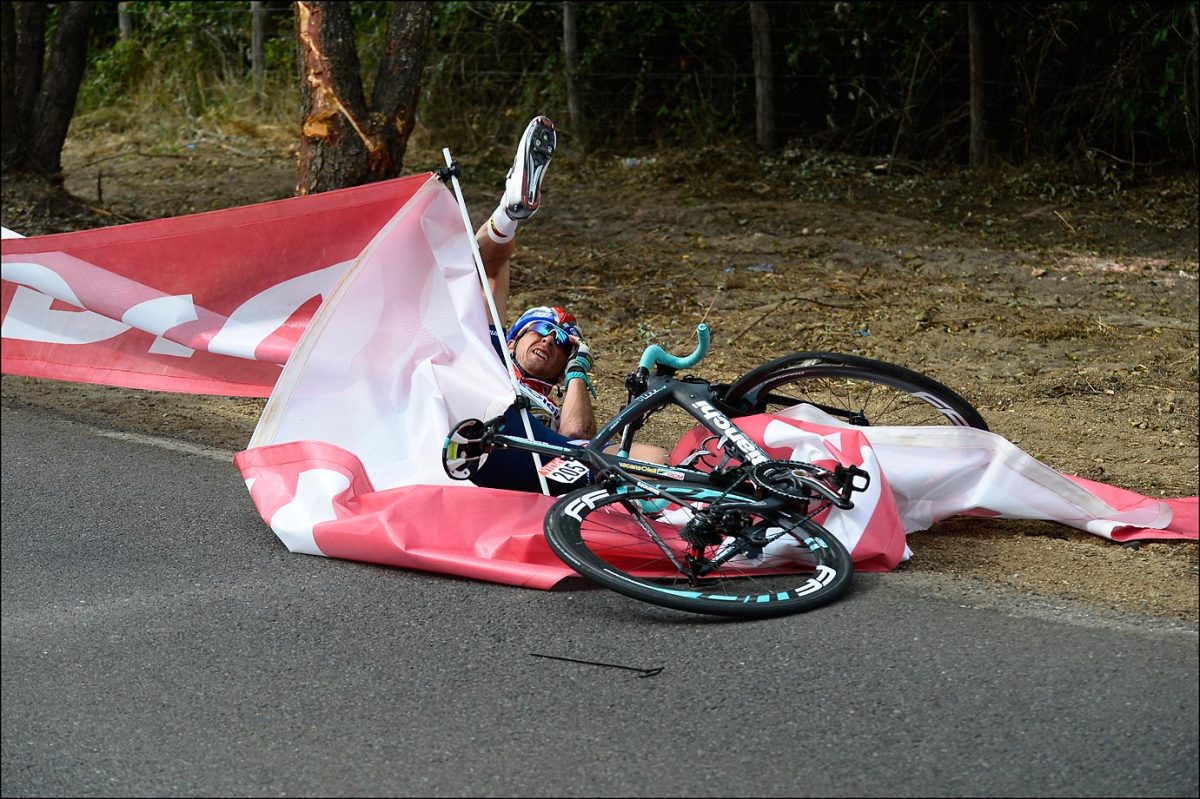
Two years after his unscheduled flight into a barbed wire fence, Holland’s Hoogerland mixed it up with an advertising banner 15 km from the finish of last year’s Stage 1. Once unwrapped, he was fine. Up ahead, however, the Orica team bus was stuck under the gantry at the finish line. The bus got unstuck before the peloton arrived, but news of incident swept through the bunch, spawning tension, anxiety and … more crashes.
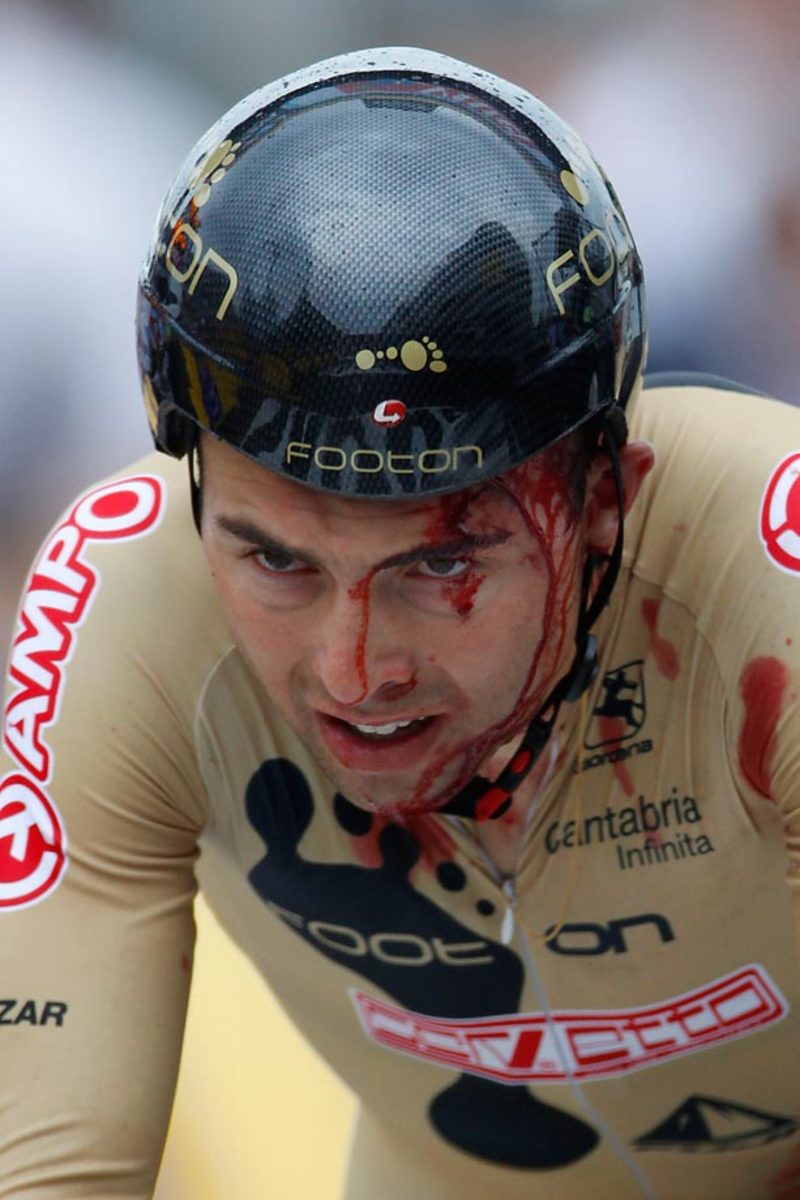
Over before it began: On the first day of his first Tour de France, Manuel Cardoso of Portugal overcooked a corner in the 8.9 km prologue and fell heavily, breaking his jaw and collarbone, ending his Tour before the first road stage.
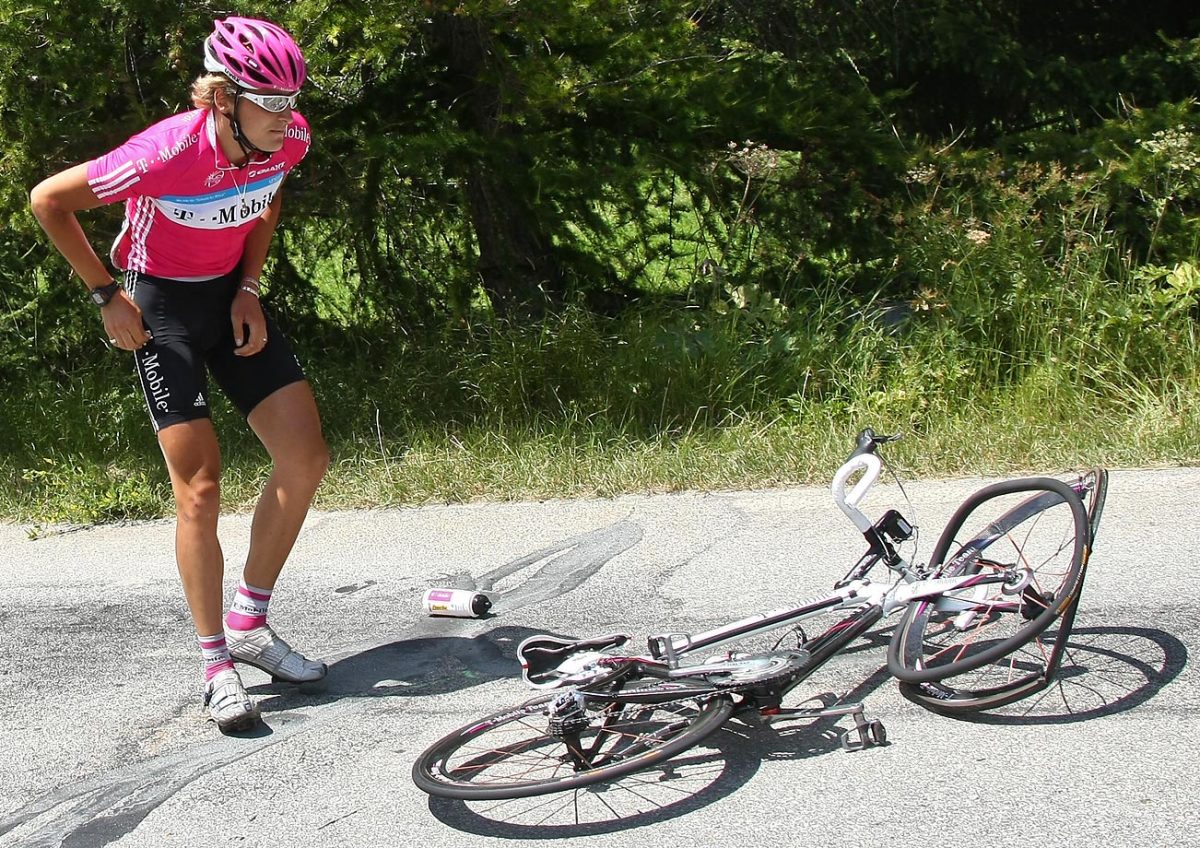
What you see is Marcus Burghardt, gingerly picking himself off the macadam during Stage 9 of the ’07 Tour. What you don’t see is the golden Labrador who meandered into the road. Burghardt braked, but still t-boned the le chien hard enough to taco the front wheel. In the end, both man and beast were fine …
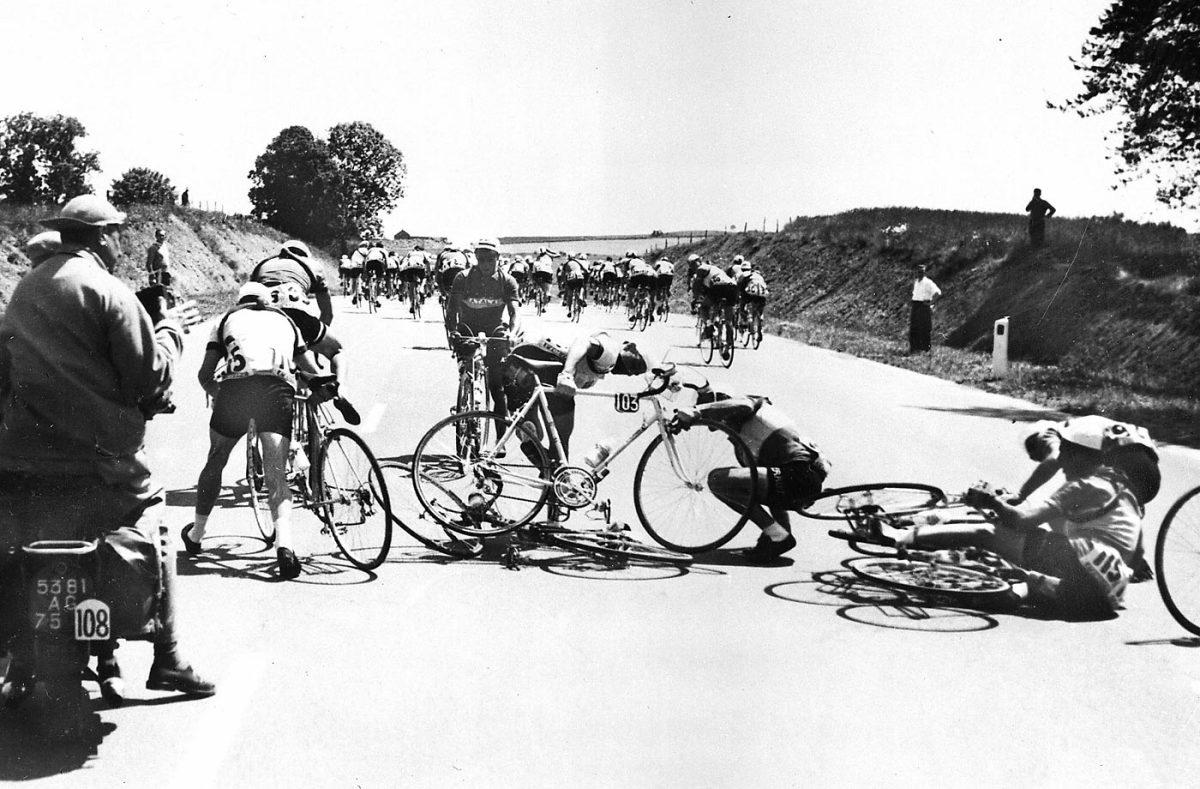
While the speeds of the crashes were slower half a century ago – this pileup took place on the road to Metz, during the fourth stage of the 1955 Tour – the thoughts of the riders looking back at their bloodied brethren are probably the same: Better you than me.
